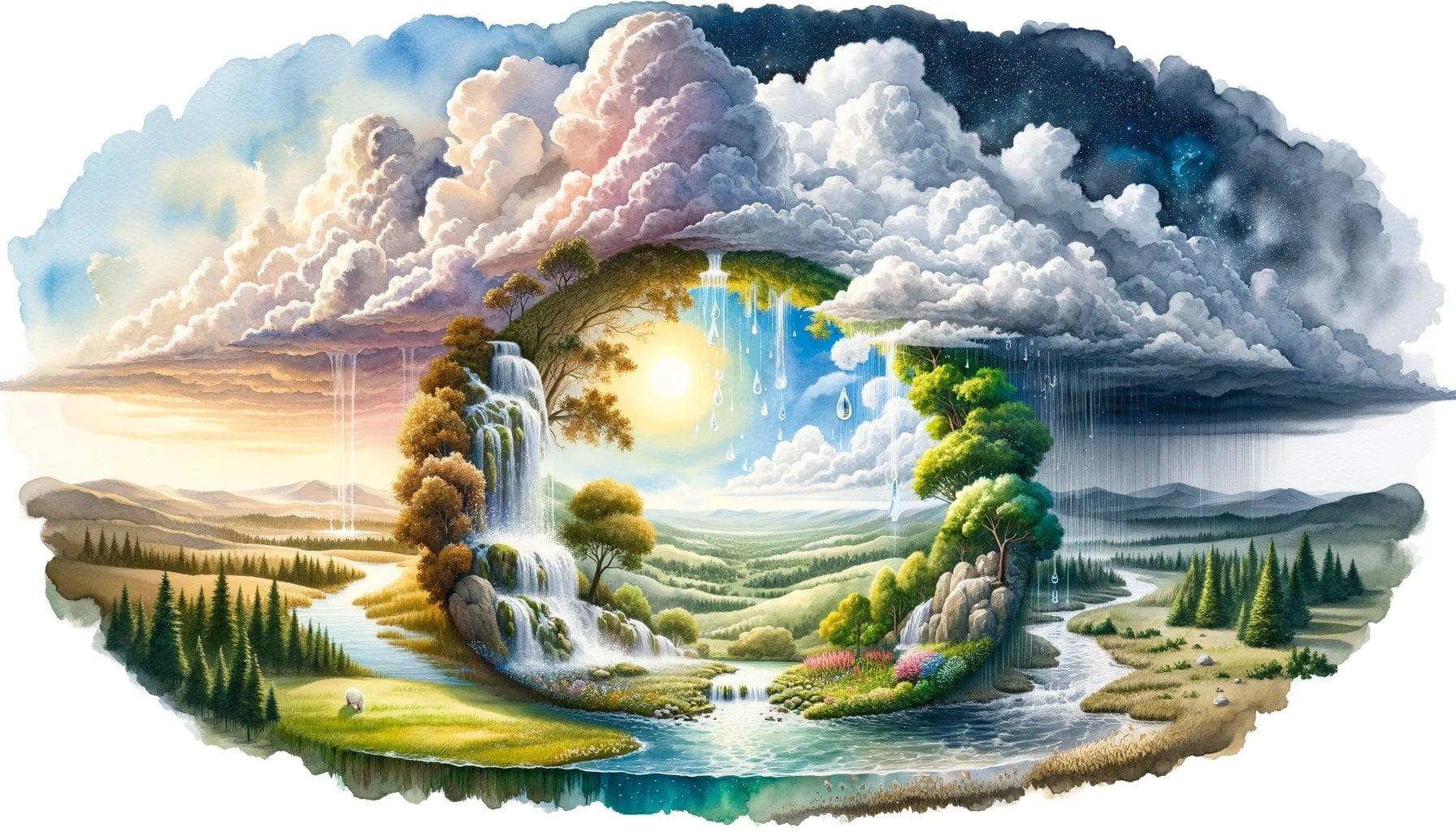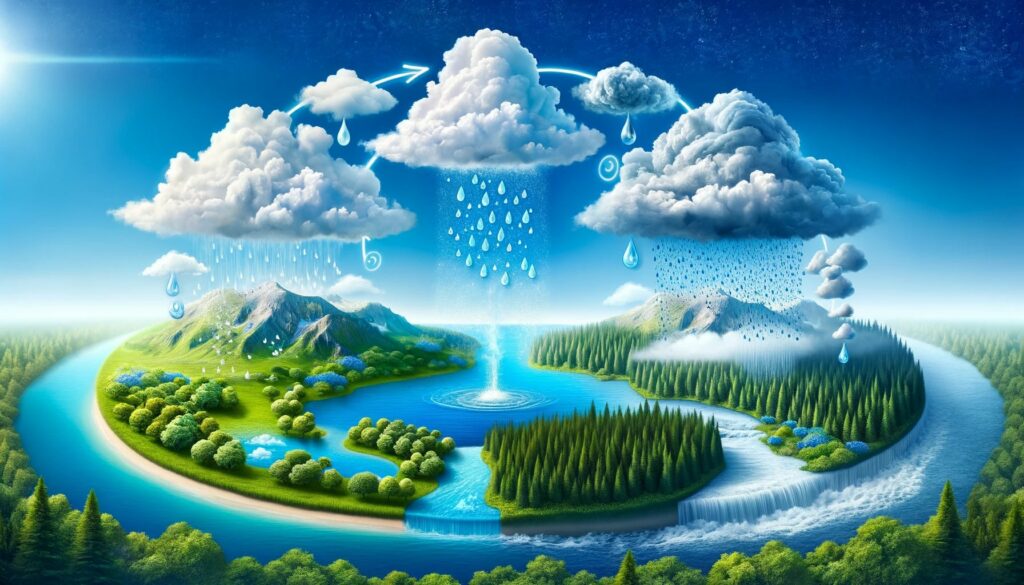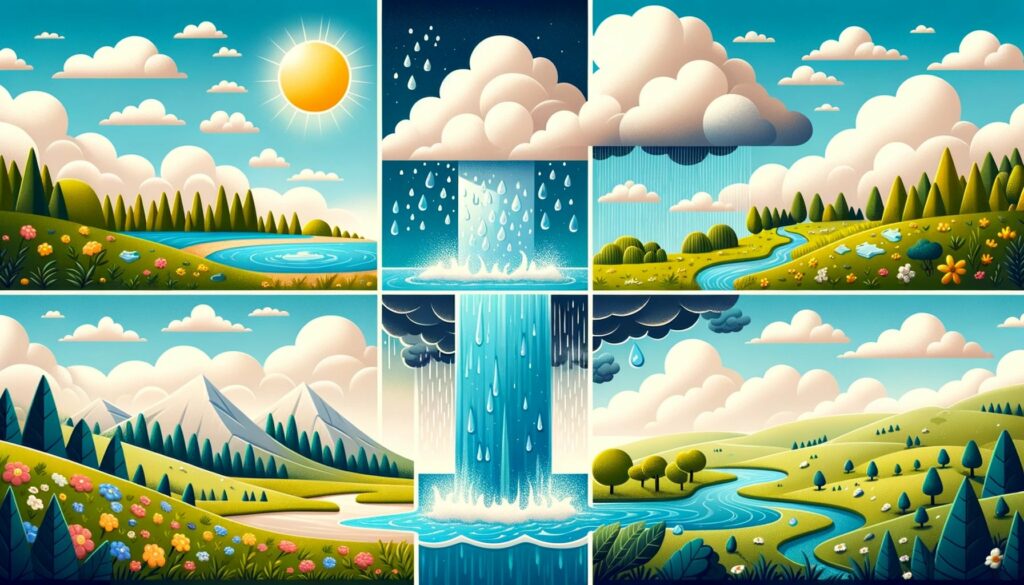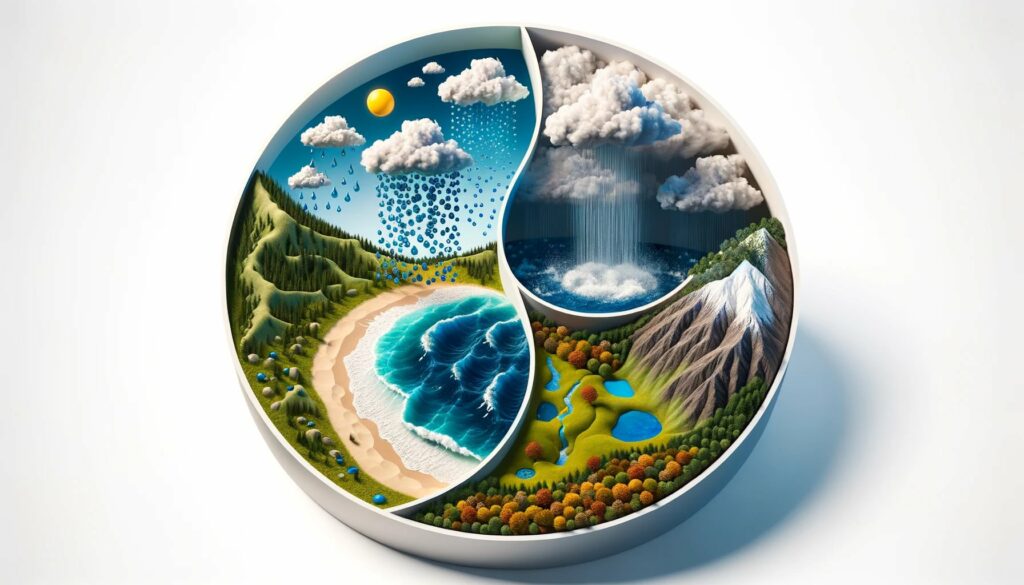The 4 Stages of the Water Cycle: Evaporation, Condensation, Precipitation, and Collection. Have you ever wondered how water moves through our planet in a perpetual cycle? In this article, we will delve into the fascinating world of the water cycle and explore its four crucial stages. From the moment water evaporates into the atmosphere to the point where it falls back to the Earth as rain or snow, each stage plays a vital role in maintaining our planet’s water resources. Join us as we unravel the mysteries of evaporation, condensation, precipitation, and collection, and gain a deeper understanding of this fundamental process that shapes our environment.
What are the 4 Stages of the Water Cycle?
The water cycle is a fascinating and essential process that drives the circulation of water in our Earth’s atmosphere. Understanding the four main stages of the water cycle is crucial in comprehending this continuous cycle of water. So, let’s dive in and explore each stage in detail.
Evaporation: Transforming Liquid into Vapor
The first stage of the water cycle is evaporation. Have you ever wondered what happens to a droplet of water when it’s exposed to the warmth of the sun? Well, it undergoes a magical transformation. The sun’s heat causes the water to change from its liquid state to water vapor, a gaseous form. This newly formed water vapor rises and enters the atmosphere, where it becomes part of the atmosphere’s composition.
Condensation: Cloud Formation and Gathering Droplets
Now that the water has transformed into vapor and joined the atmosphere, it encounters cooler temperatures as it ascends. This change in temperature prompts the water vapor to condense back into liquid droplets. These droplets gather together and form clouds. Just like how tiny ingredients combine to create a delicious recipe, these droplets join forces to create massive, fluffy clouds we often see floating above us.
Precipitation: Water Falls from the Sky
Once those clouds are saturated with enough condensed droplets, they become too heavy to remain suspended in the air. This leads to the third stage of the water cycle: precipitation. It’s nature’s way of doing a grand water ballet performance! The droplets within the clouds fall back down to the Earth’s surface in the form of precipitation, which can be rain, snow, sleet, or even hail, depending on the temperature and atmospheric conditions.
Run-off: The Journey Back to the Oceans, Lakes, and Rivers
After precipitation, the journey continues for the water droplets. Some of the droplets seep into the ground, becoming groundwater, while others flow over the surface in what we call run-off. These streams of water make their way downhill, finding their way into rivers, lakes, and eventually the vast oceans. It’s like a journey back home for the water, completing its cycle and replenishing our planet’s water resources.
Together, these four stages of the water cycle work in harmony, maintaining Earth’s water balance and regulating our climate. Without this incredible process, life as we know it would not be possible. The water cycle provides us with the precious resource of fresh water, nourishing plants, animals, and humans. Additionally, it plays a crucial role in regulating our planet’s temperature, ensuring a stable and habitable environment.
As you can see, the four stages of the water cycle are a beautiful and intricate dance of water in its various forms. The next time you witness rainfall or gaze at the mesmerizing clouds in the sky, take a moment to appreciate the wonder and importance of the water cycle. It is a true marvel of nature that sustains our planet and all living beings within it.
Table: The Four Stages of the Water Cycle
| Stage | Description |
|---|---|
| Evaporation | Water transforms from its liquid state to water vapor, rising into the atmosphere. |
| Condensation | Water vapor cools and condenses into liquid droplets, forming clouds. |
| Precipitation | Condensed water droplets become heavy and fall back to the Earth’s surface as rainfall. |
| Run-off | After precipitation, water either seeps into the ground or flows into rivers and oceans. |
Remember, the water cycle is a fascinating process that governs our planet’s water resources. By understanding the four stages of evaporation, condensation, precipitation, and run-off, we can develop a deeper appreciation for this vital cycle. So, the next time you witness rain or look up at the clouds, let it remind you of the incredible journey that each water droplet takes as it cycles through the Earth’s atmosphere.
Transpiration is a vital process in the water cycle that plays a significant role in the overall balance of our planet’s ecosystem. From plants to humans, we all depend on this natural phenomenon for our survival. If you’re curious to learn more about the intricate details of how transpiration influences the water cycle, click here: transpiration water cycle. This link will take you to a comprehensive resource that delves deeper into the subject, providing fascinating insights and expanding your knowledge on this crucial aspect of our environment. So, what are you waiting for? Dive into the world of transpiration and discover the wonders of the water cycle!
Precipitation
Precipitation is a crucial stage in the water cycle that plays a significant role in maintaining Earth’s water balance and supporting life as we know it. It occurs when condensed water droplets become heavy enough to fall back to the Earth’s surface as rainfall, snow, sleet, or hail. This process is essential for replenishing our freshwater sources, sustaining ecosystems, and providing for the needs of plants, animals, and humans.
The Formation of Precipitation
When water evaporates into the air due to the Sun’s heat, it enters the atmosphere in the form of water vapor. As this water vapor rises and gets colder, it undergoes a process called condensation. The water vapor molecules come together and condense into liquid droplets, forming clouds. These clouds can take various shapes and sizes, from wispy white to dark and dense.
Within these clouds, the water droplets colliding and merging with one another to form larger and heavier droplets. When the droplets become too heavy for the cloud to support, they fall back to the Earth’s surface as precipitation.
Types of Precipitation
Precipitation can take several forms, depending on the atmospheric conditions. The most common forms of precipitation include rain, snow, sleet, and hail.
- Rain is the most familiar form of precipitation. It occurs when liquid droplets in the clouds combine and fall to the ground as water droplets.
- Snow forms when the temperature is below freezing, and the water droplets in the cloud freeze into ice crystals. These crystals then come together to form snowflakes that fall gently to the Earth.
- Sleet is a mixture of rain and snow. It occurs when there is a warm layer of air between the cloud and the ground that causes rain to freeze into ice pellets before reaching the surface.
- Hail forms within thunderstorm clouds when strong updrafts carry raindrops upward into areas of freezing temperatures. The raindrops freeze and become layered with ice, growing larger until they eventually fall to the ground as hailstones.
All these forms of precipitation have their own unique characteristics and can vary in size, shape, and intensity depending on the atmospheric conditions.
The Importance of Precipitation
Precipitation is vital for various reasons. Firstly, it replenishes our freshwater resources, sustaining rivers, lakes, and groundwater supplies. Without precipitation, these sources would gradually deplete, leading to droughts and water scarcity.
Furthermore, precipitation plays a crucial role in supporting life on Earth. It provides the necessary moisture for plants to grow and thrive, ensuring food production and maintaining healthy ecosystems. Precipitation also contributes to cooling the Earth’s surface and helps regulate the overall climate.
Distribution of Precipitation
Once precipitation falls to the Earth, it is distributed in several ways. Some of it is returned to the atmosphere through evaporation, where the Sun’s heat transforms the water back into vapor. Some of the precipitation is intercepted by vegetation, such as leaves and branches, and evaporates from their surfaces. This process is known as transpiration and is an essential mechanism in the water cycle.
Another portion of precipitation percolates into the soil through infiltration. This infiltrated water helps replenish underground water sources, known as groundwater. These sources are important for sustaining wells, springs, and maintaining a stable water supply.
Lastly, the remaining precipitation flows directly as surface runoff into rivers, streams, and eventually the oceans. This runoff can help maintain river levels, contribute to the water cycle’s circulation, and replenish the Earth’s oceans.
Wrap Up
In conclusion, precipitation is a crucial stage in the water cycle that completes the cycle of evaporation, condensation, and collection. It plays a vital role in maintaining Earth’s water balance, regulating climate patterns, and sustaining life on our planet. From gentle rain showers to majestic snowfalls, each form of precipitation is a reminder of the water cycle’s interconnectedness and its fundamental importance for our planet’s survival. Next time you feel a raindrop or witness a snowflake, take a moment to appreciate the wonders of precipitation and its impact on our world.
Collection
In the water cycle, collection is a crucial stage that ensures the continuous movement and distribution of water on Earth. This stage plays a vital role in maintaining the planet’s water balance and providing freshwater for various ecosystems, including plants, animals, and humans. Let’s take a closer look at the process of collection and its significance in the larger context of the water cycle.
What is Collection in the Water Cycle?
Collection refers to the phase where water, in its various forms such as rain, snow, or other precipitation, is gathered and accumulated in different reservoirs. These reservoirs can include rivers, lakes, oceans, and even underground aquifers. The collection stage is responsible for bringing the precious resource of water back to the Earth’s surface, replenishing and sustaining freshwater sources.
The Role of Collection in the Water Cycle:
Collection helps in the distribution and regulation of water across different ecosystems, serving multiple purposes that are essential for life on Earth. By understanding the significance of this stage, we can develop a deeper appreciation for the interconnectedness of the water cycle and the importance of water resources.
1. Replenishing Freshwater Sources:
During the collection stage, precipitation, in the form of rain or snow, falls to the Earth’s surface. This replenishes freshwater sources, such as rivers, lakes, and underground aquifers. These sources serve as vital water reservoirs that support various life forms and provide access to freshwater for human consumption.
2. Sustaining Ecosystems:
Collection ensures the availability of water for ecosystems, including plants, animals, and microorganisms. It allows vegetation to grow, facilitating the survival of diverse species. Freshwater habitats, such as rivers and lakes, provide a home for aquatic organisms and play a crucial role in maintaining biodiversity.
3. Supporting Human Needs:
Collection plays a pivotal role in meeting human water needs. It provides a renewable source of fresh water for drinking, irrigation in agriculture, and industrial purposes. Access to clean and sustainable water sources is paramount for ensuring human health, food security, and overall socio-economic development.
4. Regulating Climate:
The collection of water, especially in large bodies such as oceans, helps regulate the Earth’s climate. Oceans act as massive heat sinks, absorbing solar radiation and releasing it gradually, influencing weather patterns and minimizing extreme temperature fluctuations. This process helps create favorable climatic conditions for life on Earth.
Collection Methods:
Collection, as a stage of the water cycle, occurs through different mechanisms that facilitate the movement of water. Some common methods include:
1. Surface Runoff:
After rainfall or snowfall, excess water flows over the land, known as surface runoff. It collects in streams, rivers, and eventually makes its way into the oceans and other bodies of water. Surface runoff plays a crucial role in the collection of water and contributes to the recharge of groundwater resources.
2. Infiltration:
Infiltration occurs when water seeps into the ground through the soil and becomes groundwater. This process is essential for replenishing underground aquifers and ensuring a sustainable supply of freshwater.
3. Catchment Systems:
Human-made structures, such as reservoirs and dams, are designed to collect and store large quantities of water. These catchment systems aid in managing freshwater resources, providing a steady supply for drinking, agriculture, and industrial purposes.
The Significance of Collection:
The collection stage is vital for maintaining a balanced water cycle and sustaining life on Earth. It ensures the availability and distribution of freshwater, which is essential for all living organisms. By understanding the importance of collection, we can appreciate the intricate connections between natural processes and human well-being.
The water cycle, with its four key stages of evaporation, condensation, precipitation, and collection, serves as a testament to the Earth’s delicate balance and the fundamental role water plays in supporting life. From the highest mountain peaks to the deepest ocean trenches, water continuously cycles through these stages, providing the foundation for ecosystems and human civilizations alike.
So, the next time you witness raindrops falling or admire the beauty of a glistening river, take a moment to reflect on the incredible journey water undergoes, including its collection, and how it shapes and sustains our planet. In doing so, we can develop a greater appreciation for this precious resource and strive to conserve and protect it for future generations.
Now that we’ve explored the intricacies of the water cycle, let’s move on to exploring the broader impacts and significance of this vital process in sustaining life on Earth.
FAQ
Q: What are the four stages of the water cycle?
A: The four stages of the water cycle are evaporation, condensation, precipitation, and collection.
Q: What is evaporation in the water cycle?
A: Evaporation is the first stage of the water cycle. It occurs when water is heated by the sun and turns into water vapor, rising into the atmosphere.
Q: What is condensation in the water cycle?
A: Condensation is the stage in the water cycle when water vapor in the atmosphere cools and gathers to form clouds. The water vapor changes back into liquid droplets due to the colder temperatures.
Q: What is precipitation in the water cycle?
A: Precipitation is the stage in the water cycle when the condensed water droplets in the clouds become too heavy and fall back to the Earth’s surface. This can take the form of rain, snow, sleet, or hail, depending on the temperature.
Q: What is collection in the water cycle?
A: Collection is the final stage of the water cycle. After precipitation, the water either seeps into the ground or runs off the surface, flowing back into oceans, lakes, and rivers. This process is known as run-off and is crucial for maintaining Earth’s water balance and climate.
- Star Ring Trends: Etsy vs Amazon - March 28, 2025
- Boost Pollinator Habitats: Baby Blue Eyes Sustainable Farming Guide - March 28, 2025
- Protect Big Black Bears: Effective Conservation Strategies - March 28, 2025



















